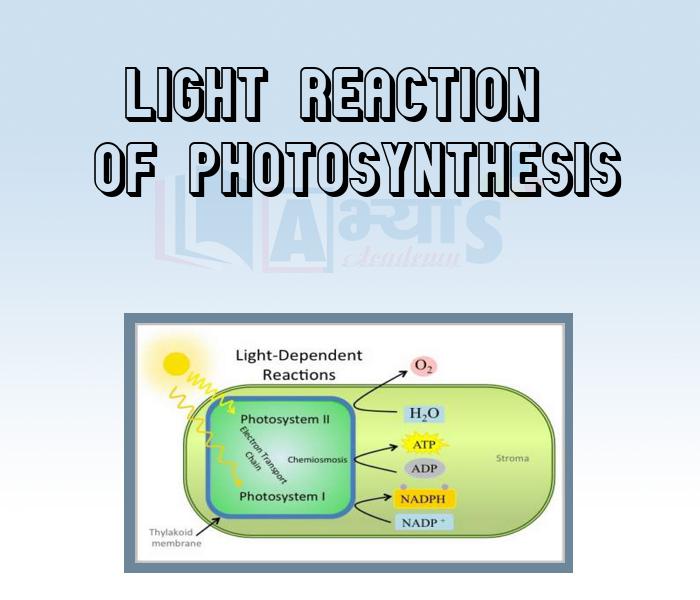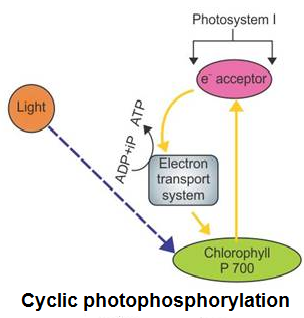Light Reaction of Photosynthesis







Light Reaction of Photosynthesis
The process of photosynthesis take place in two steps :
Light reaction includes the following steps, i.e., absorption of light, splitting of water, release of oxygen and finally the formation of high energy chemical intermediates, i.e., ATP and NADPH.
Absorption of Light :
Photosystems : - The light harvesting complexes or photosystems are made up of hundreds of pigment molecules bounded by proteins. Each photosystem has a photocentre or reaction centre, where actual reaction takes place.
This reaction centre contains a special chlorophyll-a molecule. It is fed by hundred other pigment molecules and it forms the light harvesting system called antennae. These antennae molecule absorb light of different wavelength, but shorter then reaction centre in order to make photosynthesis more efficient.
The reaction centre is different in both the photosystems as given below
Electron Transport : - The photosynthetic electron transport chain initiates with the absorption of light energy by the photosystem-II. The light of wavelength 680 nm is absorbed by the reaction centre of photosystem-II due to which a pair of electrons becomes excited and jump into an orbit away from the atomic nucleus. These electrons are then picked up by an electron acceptor, which passes them further to electron transport system consisting of cytochromes.
It is to be noted that this movement of electrons is downhill according to the redox potential scale (oxidation-reduction scale). The electrons of the electron transport chain are not used up in the chain instead they are further passed on to the pigment of PS-I.
Now, like the PS-II, the electrons in the reaction centre of PS-I also get excited on receiving red light of wavelength 700 nm and get transferred to the another electron acceptor with higher redox potential.
But this time the electron does not move to a reaction centre or chlorophyll-a. Instead, it moves to a molecule rich in energy and . On addition of these electrons the
gets reduced to
.
In 1960, Bendall and Hill discovered the Z-scheme of electron transport. It is a series of reactions that we have just studied above from the whole scheme of electron
transfer initiating from PS-II, uphill to the acceptor molecule, down the electron transport chain to PS-I, excitation of electrons and then their transfer to another acceptor and finally downhill to NADP in order to get reduced to .
Splitting of Water: - The electrons are continuously supplied to the photosystems-II by the available electrons, which get replaced due to the splitting of water.
In this process, the water splits into protons, electrons and oxygen. The complex for water splitting is associated with the photosystems-II that is located on the inner side of the thylakoid membrane. and
ions also play important role in the photolysis of water molecule.
These electrons thus, obtained by the splitting of water are needed to replace those electrons which are removed from the photosytems-I thus, are provided by photosystem-II.
While all the electrons formed, are replaced, the protons accumulated in the lumen of the thylakoid and the oxygen is evolved into the atmosphere.
Photophosphorylation: - Phosphorylation is the process through which, ATP is synthesised from ADP and inorganic phosphate (P) by the cell organelles (like mitochondria and chloroplasts). When it occurs in the presence of sunlight in chloroplast, it is called photophosphorylation.
Phosphorylation in mitochondria is not light dependent, but it uses the energy by oxidation of nutrients to produce ATP, hence it is called oxidative phosphorylation.
The process of photophosphorylation is of two types :
1. Non-cyclic Photophosphorylation : - Non-cyclic photophosphorylation is a type of photophosphorylation in which both the photosystems (PS-I and PS-II) in cooperate light driven synthesis of ATP. During this cycle, the electron released from PS-II does not return back to it hence, it is known as non-cyclic photophosphorylation. Both NADPH and ATP are formed during this reaction, are used in light independent reaction and are called reducing power.

2. Cyclic Photophosphorylation : - It is the type of photophosphorylation in which only PS-I is taking part and the electron released from the reaction centre .returns back to it after passing through a series of carrier, i.e., circulation takes within the photosystem and the phosphorylation occurs due to cyclic flow of electrons.

Site of light reaction in photosynthesis is ______________ | |||
| Right Option : C | |||
| View Explanation | |||
Dark reaction in photosynthesis __________________ | |||
| Right Option : A | |||
| View Explanation | |||
Students / Parents Reviews [20]
My experience with Abhyas academy is very nice or it can be said wonderful. I have been studying here from seven class. I have been completing my journey of three years. I am tinking that I should join Abhyas Academy in tenth class as I am seeing much improvement in Maths and English

Hridey Preet
9thIt has a great methodology. Students here can get analysis to their test quickly.We can learn easily through PPTs and the testing methods are good. We know that where we have to practice

Barkha Arora
10thIn terms of methodology I want to say that institute provides expert guidence and results oriented monitering supplements by requsite study material along with regular tests which help the students to improve their education skills.The techniques of providing education helps the students to asses...

Aman Kumar Shrivastava
10thWe started with lot of hope that Abhyas will help in better understnding of complex topics of highers classes. we are not disappointed with the progress our child has made after attending Abhyas. Though need to mention that we expected a lot more. On a scale of 1-10, we would give may be 7.

Manya
8thMy experience with Abhyas Academy has been very good. When I was not in Abhyas whenever teacher ask questions I could not speak it confidently but when I came in Abhyas, my speaking skills developed and now I am the first one to give the answer of teachers question.

Upmanyu Sharma
7thAbhyas is good institution and a innovative institute also. It is a good platform of beginners.Due to Abhyas,he has got knoweledge about reasoning and confidence.My son has improved his vocabulary because of Abhyas.Teacher have very friendly atmosphere also.

Manish Kumar
10thIt was good as the experience because as we had come here we had been improved in a such envirnment created here.Extra is taught which is beneficial for future.

Eshan Arora
8thBeing a parent, I saw my daughter improvement in her studies by seeing a good result in all day to day compititive exam TMO, NSO, IEO etc and as well as studies. I have got a fruitful result from my daughter.

Prisha Gupta
8thAbhyas institute is one of the best coaching institute in the vicinity of Ambala cantt.The institute provides good and quality education to the students.The teachers are well experienced and are very helpful in solving the problems. The major advantages of the institute is extra classes for weak...

Shreya Shrivastava
8thMy experience with Abhyas is very good. I have learnt many things here like vedic maths and reasoning also. Teachers here first take our doubts and then there are assignments to verify our weak points.

Shivam Rana
7thMy experience was very good with Abhyas academy. I am studying here from 6th class and I am satisfied by its results in my life. I improved a lot here ahead of school syllabus.

Ayan Ghosh
8thThe experience was nice. I studied here for three years and saw a tremendous change in myself. I started liking subjects like English and SST which earlier I ran from. Extra knowledge gave me confidence to overcome competitive exams. One of the best institutes for secondary education.

Aman Kumar Shrivastava
10thAbhyas Methodology is very good. It is based on according to student and each child manages accordingly to its properly. Methodology has improved the abilities of students to shine them in future.

Manish Kumar
10thAbhyas institute is one of the best coaching institute in the vicinity of Ambala Cantt area. The teachers of the institute are well experienced and very helpful in solving the problems of the students.The good thing of the institute is that it is providing extra classes for the students who are w...

Aman Kumar Shrivastava
10thMy experience with Abhyas academy is very good. I did not think that my every subject coming here will be so strong. The main thing is that the online tests had made me learn here more things.

Hiya Gupta
8thAbhyas is an institute of high repute. Yogansh has taken admission last year. It creates abilities in child to prepare for competitive exams. Students are motivated by living prizes on basis of performance in Abhyas exams. He is satisfied with institute.

Yogansh Nyasi
7thAbhyas academy is great place to learn. I have learnt a lot here they have finished my fear of not answering.It has created a habit of self studying in me.The teachers here are very supportive and helpful. Earlier my maths and science was good but now it has been much better than before.

Barkha Arora
10thWhen I have not joined Abhyas Academy, my skills of solving maths problems were not clear. But, after joining it, my skills have been developed and my concepts of science and SST are very well. I also came to know about other subjects such as vedic maths and reasoning.

Sharandeep Singh
7thThird consective year,my ward is in Abhyas with nice experience of admin and transport support.Educational standard of the institute recumbent at satisfactory level. One thing would live to bring in notice that last year study books was distributed after half of the session was over,though study ...

Ayan Ghosh
8thOne of the best institutes to develope a child interest in studies.Provides SST and English knowledge also unlike other institutes. Teachers are co operative and friendly online tests andPPT develope practical knowledge also.
